| Personal collection—Dr.Roy Francis
Dr. Francis has been a general practitioner in Snowtown, South Australia for 24 years (1970 1994). During this time he practiced what is now called “total patient care”. He was able to perform simple haematology and clinical chemistry tests, use Cardiophone to send ECG results to specialists in Adelaide and perform simple surgery and obstetric procedures on his patients.
Over the period of time he collected many important items of medical heritage. They are now stored in his care. We are most grateful for his permission to photograph the relevant items
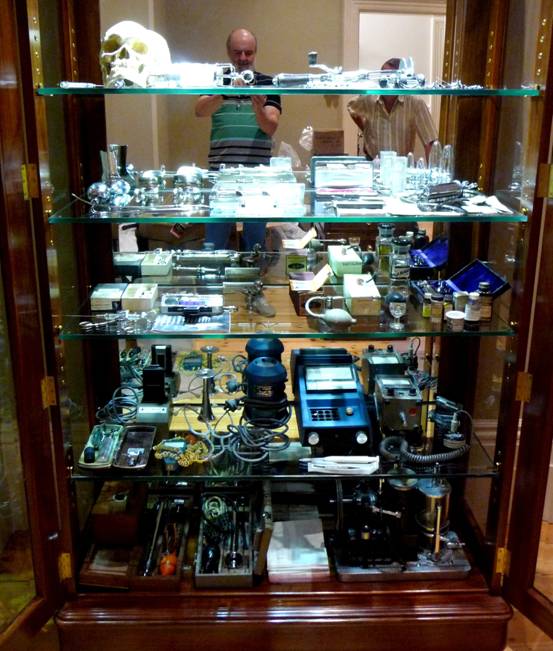
Glass cupboard exhibiting medical items from Dr.Francis’ surgery
 Cardiophne: Before the fax arrived the Cardiophone was used to transmit ECG tracings by telephone. The connection was plugged into a patient’s monitor (lower right)and the sender was attached to the telephone ear-piece (left). a second telephone line had to be used for communication. Cardiophne: Before the fax arrived the Cardiophone was used to transmit ECG tracings by telephone. The connection was plugged into a patient’s monitor (lower right)and the sender was attached to the telephone ear-piece (left). a second telephone line had to be used for communication.
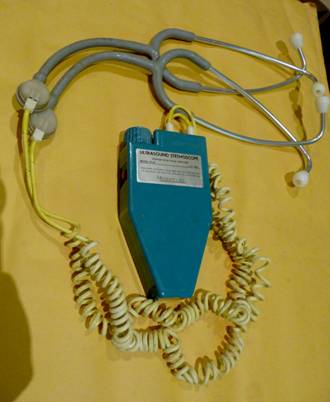 An ultra-sound foetal stethoscope: The blue microphone was placed on the mother’s abdomen and the volume was adjusted by the blue knurled knob. Both mother and nurse or doctor had individual ear-pieces An ultra-sound foetal stethoscope: The blue microphone was placed on the mother’s abdomen and the volume was adjusted by the blue knurled knob. Both mother and nurse or doctor had individual ear-pieces
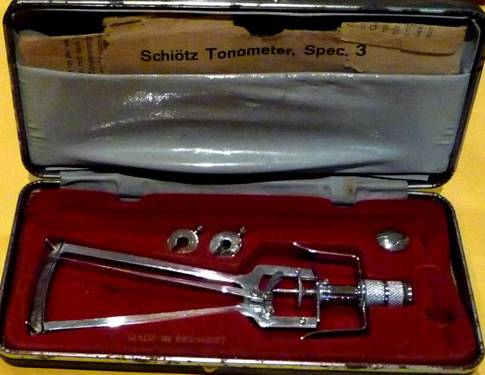 A Schiotz tonometer was used to measure intraocular pressure in order to diagnose glaucoma A Schiotz tonometer was used to measure intraocular pressure in order to diagnose glaucoma
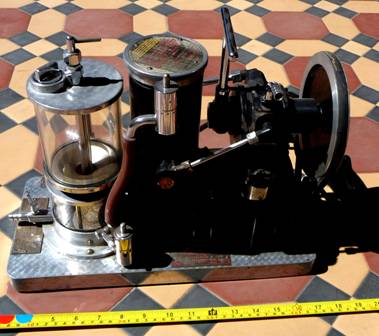 An ether machine used to administer general aneasthesia. It had an electric motor and there was a considerable risk of explosion because of possible sparking. It was particularly dangerous if the apparatus was placed on the floor because of the relatively higher density of ether to air. An ether machine used to administer general aneasthesia. It had an electric motor and there was a considerable risk of explosion because of possible sparking. It was particularly dangerous if the apparatus was placed on the floor because of the relatively higher density of ether to air.
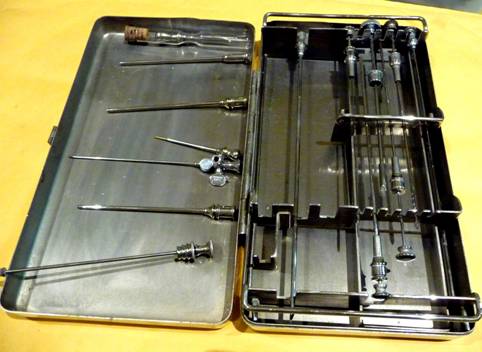 A stainless steel container with needles, trocars and room for two syringes A stainless steel container with needles, trocars and room for two syringes
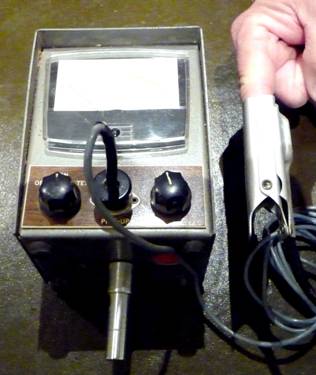 An early (1960) pulse monitor attached to the rt. index finger An early (1960) pulse monitor attached to the rt. index finger
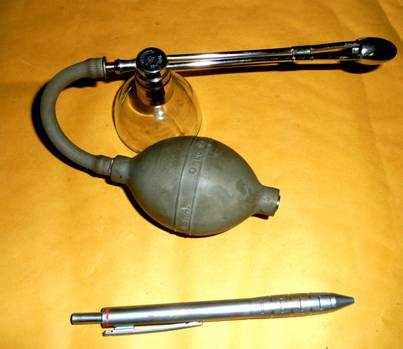 An atomiser used to deliver an anaesthetic spray to the pharynx for laryngoscopy An atomiser used to deliver an anaesthetic spray to the pharynx for laryngoscopy

Label on the spray container box

A smaller version used to spray cocaine as an anaesthetic agent.
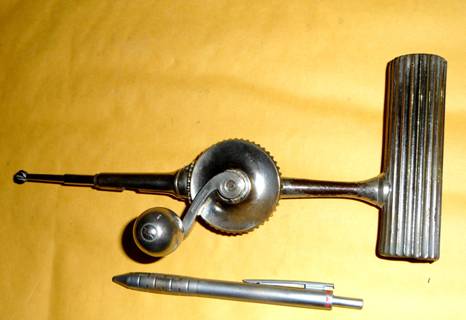 A bone drill possibly used in mastoid surgery A bone drill possibly used in mastoid surgery
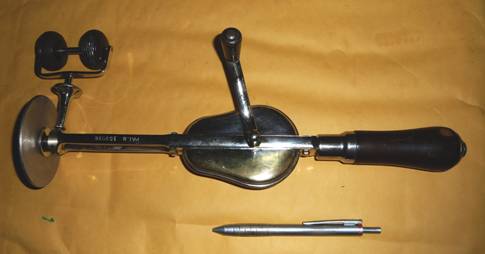 A simple massage machine: Turning the handle vibrates the bakelite wheels A simple massage machine: Turning the handle vibrates the bakelite wheels
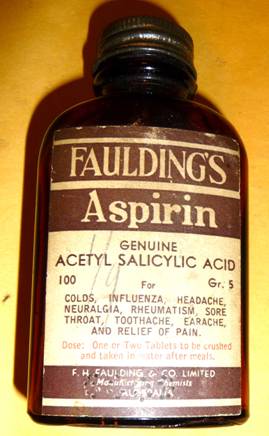
An aspirin container manufactured by the Adelaide firm of Fauldings. The dose is indicated in grains. (one grain = 60 milligrams}
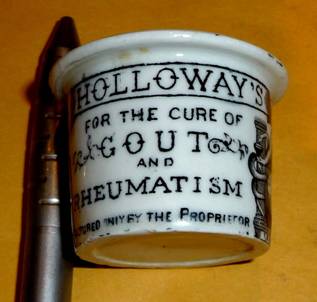 An ointment container An ointment container
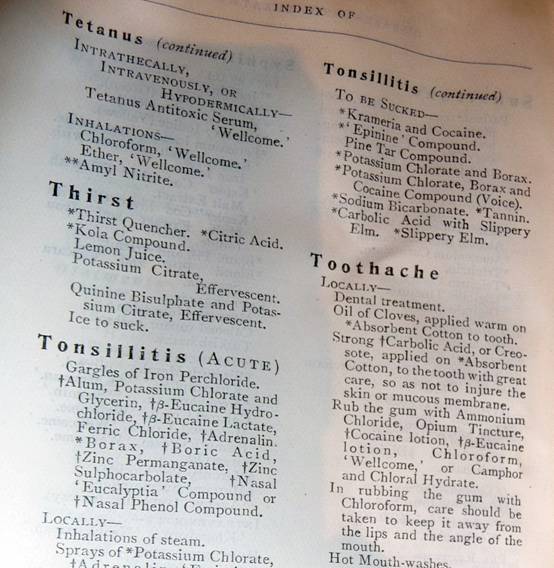 Text from an almanac describing treatments for tetanus, tonsillitis and toothache Text from an almanac describing treatments for tetanus, tonsillitis and toothache
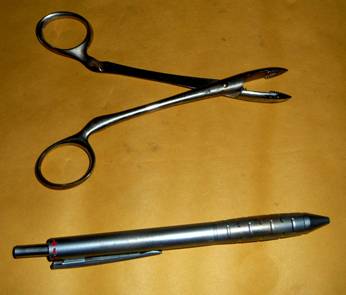 An unusual forceps. The gap is not common. An unusual forceps. The gap is not common.
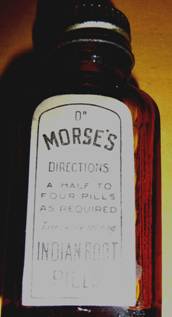 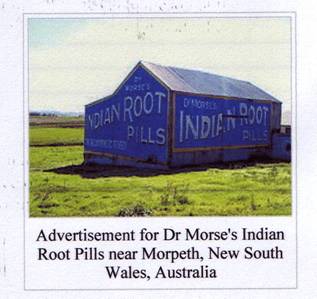 Dr Morse’s Indian Root tablets, developed by Andrew B Moore in the USA in 1854 and later manufactured by William Henry Comstock and his father Edwin in New York. Dr Morse’s Indian Root tablets, developed by Andrew B Moore in the USA in 1854 and later manufactured by William Henry Comstock and his father Edwin in New York.
They claimed that their tablets would “clean the blood” and cure all sorts of ills.
A shed advertising the Australian version on the right.
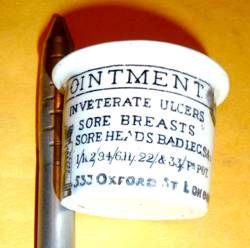 A nonspecific ointment from London and its claims A nonspecific ointment from London and its claims
.
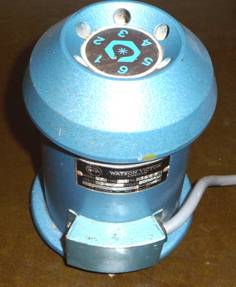 A simple centrifuge used by Dr.Francis to separate red and white cells from blood and produce serum to be used in the Unimeter 250 A simple centrifuge used by Dr.Francis to separate red and white cells from blood and produce serum to be used in the Unimeter 250
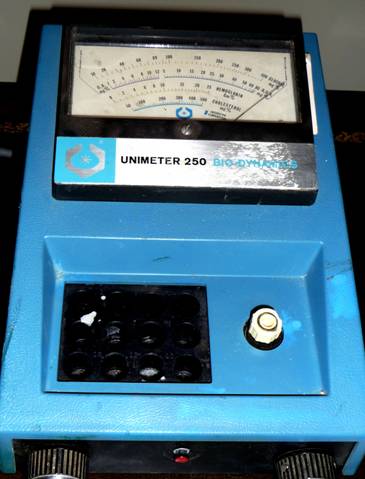 A Unimeter 250 purchased by Dr.Francis in the 1970s. It was used to measure blood glucose, haemoglobin and cholesterol A Unimeter 250 purchased by Dr.Francis in the 1970s. It was used to measure blood glucose, haemoglobin and cholesterol
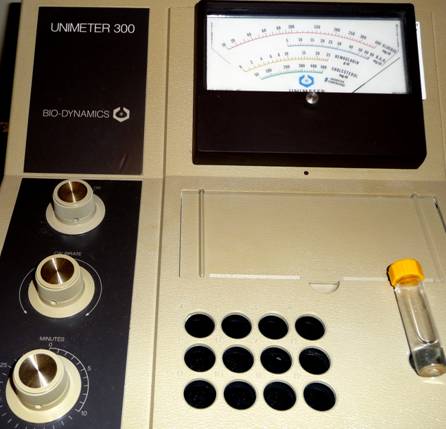 A later model of the uniMeter (300) It could determine seven more blood components such as LDH, alkaline phosphatase, creatinine and electrolytes. A later model of the uniMeter (300) It could determine seven more blood components such as LDH, alkaline phosphatase, creatinine and electrolytes.
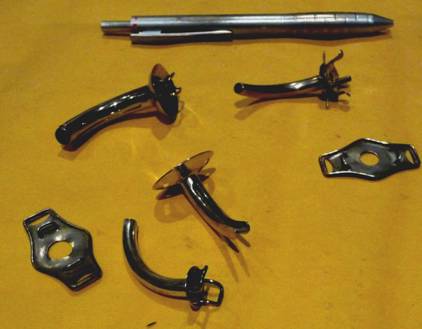 Different sizes of trachaeostomy tubes used in diphtheria epidemics Different sizes of trachaeostomy tubes used in diphtheria epidemics
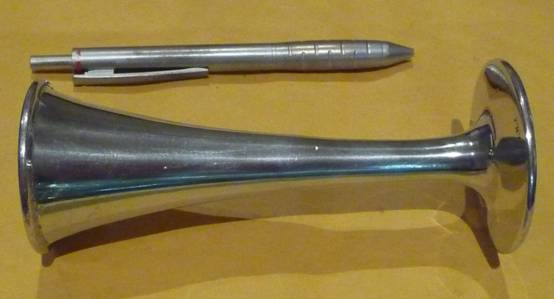 An early “stethoscope” used to listen to foetal heartsounds. the left end was placed on th mother’s abdomen. After the ultrasound arrived it became obsolete. An early “stethoscope” used to listen to foetal heartsounds. the left end was placed on th mother’s abdomen. After the ultrasound arrived it became obsolete.
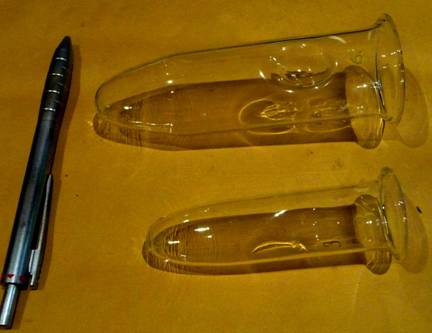
Two sets of vaginal dilators
-o0o-
|


 Cardiophne: Before the fax arrived the Cardiophone was used to transmit ECG tracings by telephone. The connection was plugged into a patient’s monitor (lower right)and the sender was attached to the telephone ear-piece (left). a second telephone line had to be used for communication.
Cardiophne: Before the fax arrived the Cardiophone was used to transmit ECG tracings by telephone. The connection was plugged into a patient’s monitor (lower right)and the sender was attached to the telephone ear-piece (left). a second telephone line had to be used for communication.  An ultra-sound foetal stethoscope: The blue microphone was placed on the mother’s abdomen and the volume was adjusted by the blue knurled knob. Both mother and nurse or doctor had individual ear-pieces
An ultra-sound foetal stethoscope: The blue microphone was placed on the mother’s abdomen and the volume was adjusted by the blue knurled knob. Both mother and nurse or doctor had individual ear-pieces A Schiotz tonometer was used to measure intraocular pressure in order to diagnose glaucoma
A Schiotz tonometer was used to measure intraocular pressure in order to diagnose glaucoma An ether machine used to administer general aneasthesia. It had an electric motor and there was a considerable risk of explosion because of possible sparking. It was particularly dangerous if the apparatus was placed on the floor because of the relatively higher density of ether to air.
An ether machine used to administer general aneasthesia. It had an electric motor and there was a considerable risk of explosion because of possible sparking. It was particularly dangerous if the apparatus was placed on the floor because of the relatively higher density of ether to air.  A stainless steel container with needles, trocars and room for two syringes
A stainless steel container with needles, trocars and room for two syringes An early (1960) pulse monitor attached to the rt. index finger
An early (1960) pulse monitor attached to the rt. index finger An atomiser used to deliver an anaesthetic spray to the pharynx for laryngoscopy
An atomiser used to deliver an anaesthetic spray to the pharynx for laryngoscopy

 A bone drill possibly used in mastoid surgery
A bone drill possibly used in mastoid surgery A simple massage machine: Turning the handle vibrates the bakelite wheels
A simple massage machine: Turning the handle vibrates the bakelite wheels


 An unusual forceps. The gap is not common.
An unusual forceps. The gap is not common.
 Dr Morse’s Indian Root tablets, developed by Andrew B Moore in the USA in 1854 and later manufactured by William Henry Comstock and his father Edwin in New York.
Dr Morse’s Indian Root tablets, developed by Andrew B Moore in the USA in 1854 and later manufactured by William Henry Comstock and his father Edwin in New York.  A nonspecific ointment from London and its claims
A nonspecific ointment from London and its claims A simple centrifuge used by Dr.Francis to separate red and white cells from blood and produce serum to be used in the Unimeter 250
A simple centrifuge used by Dr.Francis to separate red and white cells from blood and produce serum to be used in the Unimeter 250 A Unimeter 250 purchased by Dr.Francis in the 1970s. It was used to measure blood glucose, haemoglobin and cholesterol
A Unimeter 250 purchased by Dr.Francis in the 1970s. It was used to measure blood glucose, haemoglobin and cholesterol A later model of the uniMeter (300) It could determine seven more blood components such as LDH, alkaline phosphatase, creatinine and electrolytes.
A later model of the uniMeter (300) It could determine seven more blood components such as LDH, alkaline phosphatase, creatinine and electrolytes. 
 An early “stethoscope” used to listen to foetal heartsounds. the left end was placed on th mother’s abdomen. After the ultrasound arrived it became obsolete.
An early “stethoscope” used to listen to foetal heartsounds. the left end was placed on th mother’s abdomen. After the ultrasound arrived it became obsolete. 